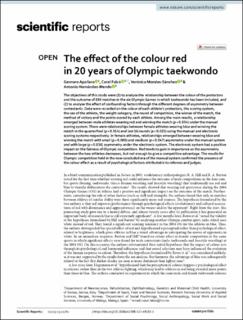| dc.contributor.author | Apollaro, Gennaro | |
| dc.contributor.author | Falco, Coral | |
| dc.contributor.author | Morales-Sánchez, Verónica | |
| dc.contributor.author | Hernández-Mendo, Antonio | |
| dc.date.accessioned | 2023-12-22T10:09:57Z | |
| dc.date.available | 2023-12-22T10:09:57Z | |
| dc.date.created | 2023-12-19T14:09:54Z | |
| dc.date.issued | 2023 | |
| dc.identifier.citation | Scientific Reports. 2023, 13 (1), . | en_US |
| dc.identifier.issn | 2045-2322 | |
| dc.identifier.uri | https://hdl.handle.net/11250/3108764 | |
| dc.description.abstract | The objectives of this study were (1) to analyse the relationship between the colour of the protectors and the outcome of 895 matches in the six Olympic Games in which taekwondo has been included, and (2) to analyse the effect of confounding factors through the different degrees of asymmetry between contestants. Data were recorded on the colour of each athlete’s protectors, the scoring system, the sex of the athlete, the weight category, the round of competition, the winner of the match, the method of victory and the points scored by each athlete. Among the main results, a relationship emerged between male athletes wearing red and winning the match (p = 0.034) under the manual scoring system. There were relationships between female athletes wearing blue and winning the match in the quarterfinal (p = 0.014) and last 16 rounds (p = 0.021) using the manual and electronic scoring systems respectively. In female athletes, relationships emerged between wearing blue and winning the match with small (p = 0.008) and medium (p = 0.047) asymmetry under the manual system and with large (p = 0.036) asymmetry under the electronic system. The electronic system had a positive impact on the fairness of Olympic competition. Red tends to gain in importance as the asymmetry between the two athletes decreases, but not enough to give a competitive advantage. The results for Olympic competition held in the now concluded era of the manual system confirmed the presence of the colour effect as a result of psychological factors attributable to referees and judges. | en_US |
| dc.language.iso | eng | en_US |
| dc.publisher | Nature Research | en_US |
| dc.rights | Navngivelse 4.0 Internasjonal | * |
| dc.rights.uri | http://creativecommons.org/licenses/by/4.0/deed.no | * |
| dc.title | The effect of the colour red in 20 years of Olympic taekwondo | en_US |
| dc.type | Peer reviewed | en_US |
| dc.type | Journal article | en_US |
| dc.description.version | publishedVersion | en_US |
| dc.rights.holder | © The Author(s) 2023 | en_US |
| dc.source.pagenumber | 0 | en_US |
| dc.source.volume | 13 | en_US |
| dc.source.journal | Scientific Reports | en_US |
| dc.source.issue | 1 | en_US |
| dc.identifier.doi | 10.1038/s41598-023-49103-3 | |
| dc.identifier.cristin | 2215673 | |
| dc.source.articlenumber | 21780 | en_US |
| cristin.ispublished | true | |
| cristin.fulltext | original | |
| cristin.qualitycode | 1 | |

